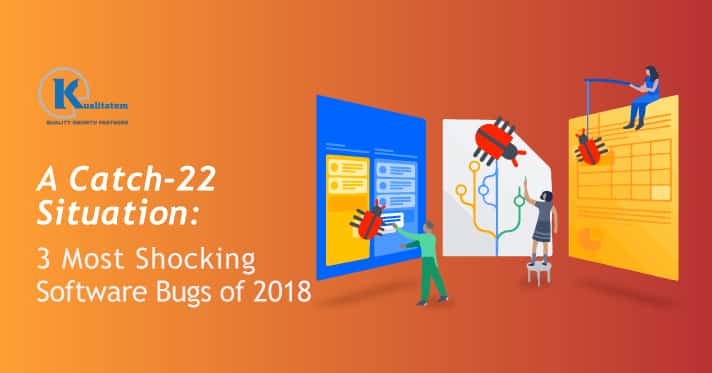A Catch-22 Situation: 3 Most Shocking Software Bugs of 2018

- June 25, 2018
- Kualitatem
Every day, testers give a go-ahead to a product that has been meticulously tested enough to ensure that it meets customer experience and is free of software bugs. But sadly, some broken codes and hidden bugs hijack the product, giving rise to issues that disrupt the functionality completely.
These bugs lead to software failure dilemmas that cause unbelievable losses to the private data, revenues, and reputations. Some of them are harmful enough to cause irreversible damage!
2018 has seen some pernicious bugs that caught everyone by surprise. Read on to find out what these bugs are. Let us share with you the 3 most interesting yet harmful bugs of 2018:
1. Hawaii False Alarm Went Wrong!
The Hawaii false alarm is a sheer example of human error and lack of precautions. On January 13, the citizens of Hawaii came across a crucial situation and were advised to cover their faces of an incoming ballistic missile attack. Later, it was declared a false alarm, although it remained under scrutiny for more than 30 minutes and affected several people to suffer from severe heart attacks and other traumas to many.
Inquiries revealed that it was an ignored human error caused due to poor security testing and design breakage in the Hawaii Emergency Management Agency’s alert software.
The Agency was penalized for having no apparent differences between their testing and live alert environments, which made it quite easy for the employees to assume a mistaken environment.
No one knew a misunderstood bug could cause a huge harm. This is why security testing is crucial!
2. Uber Self Driving Cars More Fatal Than Usual Cars!
The self-driving or self-controlling future is here. Many tech giants like Uber, Tesla, BMW, etc., have already started practicing it., But, a lot of software testing sessions need to be executed till the technology reaches perfection.
The aftermath of a lethal accident in Arizona raised brows and a series of questions about people’s safety, putting Uber tech experts under pressure.
This is what happened. a terrible accident took place on March 21, 2018, in Arizona, when a bicycling woman was hit a newly introduced Uber’s autonomous cars. The unfortunate victim could not bear the injuries and died in the hospital.
The irony is that self-driving cars are eminently promoted as a more secure replacement for driving that uses innovative technologies to prevent any roadside calamities.
A point of curiosity rises here that if such a dreadful incident happens who should the authorities blame? Uber on a whole or the car’s regulator?
The growth of these autonomous software applications or services demands changes in legislation to secure the future against any bodily and data damage. It needs to be meticulously ensured that self-controlling software needs to checked thoroughly against all chances of vulnerabilities to resolve the issue in a sensible way.
3. Intel fall victim of “Spectre” in its own microchips!
The security researchers from Google, Cyberus Technology, and the Graz University of Technology revealed a prominent security flaw, named “Spectre” that exists in almost every Intel micro-processing chip established in the last 10 years. The security loophole makes it easier for hackers to partially reach and discriminate the layout and content information stored in the guarded memory kernels.
Spectre is expected to affect all smartphones, tablets, and personal computers run by Intel microchips.
Intel is a giant company that has its products, hardware, and software products widely distributed around the globe, which is why a severe security flaw such as this can take a long time to fix. The wide-reaching availability of sources demands strong customer data privacy. It is unsure how long would it take and how massive cyber disruption would happen to make the mega IT companies realize their concerns towards the user privacy and security importance.
We hope lawsuits like GDPR can help secure the cyberspace from oncoming disruptive software failures. We can only say, let’s the future do the talking! But, in order to avoid all kinds of software bugs or software fails of any sort, it is imperative to conduct thorough testing of the application’s performance before launching it in the market.











